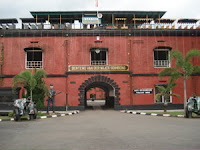The archaeological sites of Majapahit consist, for the most part, of the remains of religious foundations, or candi, built usually from stone or brick. From the two most important and informative literary sources dealing with the history of Majapahit, the Nagarakertagama and Pararaton, we learn that a large number of sacred buildings were constructed as memorial shrines to deceased rulers and their families.



The death of a king or queen saw the beginning of a series of funeral rites designed to guide the departed soul back to the source from which it had originated. These rites culminated in the shraddha ceremony, held 12 years after death, upon completion of which it was believed that final liberation was ensured. In memory of the deceased,a stone image of a god or goddess, with whom the ruler had been identified in life, was fashioned as an 'ideal portrait' and placed within a shrine.



The Nagarakertagama gives a very complete description of the sbraddha ceremony conducted on behalf of the Rajapatni, grandmother of King Hayam Wuruk, in the year 1362. It appears that more important rulers often had monuments built in several places, and were further identified with more than one divine image. Thus, King Wishnuwardhana of singosari Shiwa at Waleri (Blitar) and as Amoghapasha (a Buddhist form) at Candi Jajaghu, east of Malang. Likewise, his son and successor, Kertanagara, had memorial shrines built at Pandaan (Candi Jawi) and at Singosari.



The Pararaton is especially informative concerning the names and locations of the shrines dedicated to the royal families of Singosari and Majapahit ( see page 158). The word candi, which is commonly used to identify ancient remains dating from Indonesia's classical period, needs some explanation.


The term is generally accepted today as stemming from the sanskrit candika, a name of the Hindu goddess Durga, who inhabits the graveyard. Technically speaking, therefore candi is used to denote an ancient tomb or shrine.In reality, however, we find the word employed in a much wider context, and nowadays it is applied to all manner of archaeological sites, including gateways and bathing places. In a contemporary context, then, a candi may be seen as a place containing a residing spirit, revered for both its age as well as its qualities of mystery. In this sense, it is not different to a pusaka, or sacred heirloom.


The Nagarakertagama differentiates four types of sacred building, but it is difficult to know with certainty which ones among them are properly candi and which are not. It has been suggested that buildings referred to as dharma baji, of which 27 are listed, may be considered as royal shrines. These include Kagenengan, Tumapel, Kidal, Jajaghu, Weda-wedwan, Tudan, Pikatan, Bukul,Jawa-jawa, Antang, Antasari, Kalangbret,Jaga, Balitar, Cilabrit, Waleri, Babeg, Kukap, Lumbang, Pagor, Antahpura, Segala, Simping, Ranggapura, Buddhi Kuncir, Prajnaparamitapuri and Bhayalango.






















































